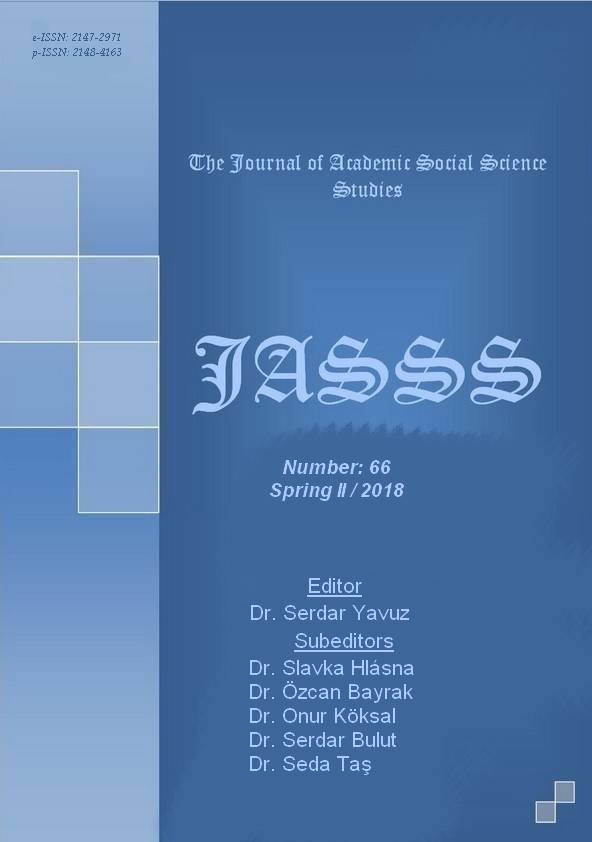Author :
Abstract
Tamsayılar, matematik öğretiminde birçok konuya temel teşkil eden, birçok sayı kümesinin temelini oluşturan ve günlük hayatta uygulama alanı bulabilen kavramlardan birisidir. Öğrencilerin tamsayılara yönelik kavram imajlarının araştırılmasının tamsayı kavramının öğrenilme süreçlerine katkı getireceği öngörülmektedir. Özellikle öğrencilerin tamsayı kavramından ne anladıklarının kendi bakış açılarıyla belirlenmesi daha geçerli tespitlerin yapılarak öğrencilerin eksiklerinin giderilmesine olanak sağlayabilir. Bu nedenle çalışmanın amacı, öğrenci gözüyle tamsayılara yönelik kavram imajlarının değerlendirilmesidir. Bu doğrultuda çalışma, nitel araştırma yöntemlerinden durum çalışması kullanılarak düzenlenmiştir. Çalışmanın katılımcılarını 2015-2016 eğitim-öğretim yılında Sakarya ilinde bir devlet okulunda öğrenim gören 7. sınıf 27 öğrenci oluşturmaktadır. Öğrencilerin tamsayılara yönelik kavram imajlarını belirlemek üzere, veriler araştırmacılar tarafından hazırlanan 7 açık uçlu sorudan oluşan “Tamsayı Kavram Testi”nden (TKT) elde edilmiştir. Öğrenci cevapları detaylı bir şekilde incelenerek betimsel analiz ile çözümlenmiştir. Araştırmanın bulgularına göre; öğrencilerin çoğunluğunun tamsayı kavramını anlamlandırmada istenilen düzeyde olmadıkları; kendi açılarından bölme ve çarpma işlemlerinde yaşadıkları zorluklar nedeniyle tamsayı imajlarının yeterli düzeyde oluşmadığı tespit edilmiştir. Bu nedenle öğrencilerin tamsayılarla işlem yapmada birçok hata yaptıkları gözlenmiştir. Bu durum öğrencilerde kavram yanılgılarının oluşmasına ve bu kavramları öğrenirken zorluk yaşamalarına sebep olabilir. Öğrencilere tamsayı tanımının ezberletilmesi ve işlemlerin ağırlıklı olarak yapılmasının yerine kavramla ilgili yeterince etkinlik düzenlenerek öğrencilerin kavram tanımları ile kavram imajlarını birbirine yakınlaştıracak öğrenme ortamları düzenlenebilir.
Keywords
Abstract
Integers are one of the concepts that form the basis of many subjects in the teaching of mathematics, which form the basis of many sets of numbers and which can find application areas in everday life. It’s envisaged that the research of the concept images of the students will contribute to the learning process of the integers. The fact that students understand from the concept of integer can be determined by their own perspectives, which can make it possible to correct the deficiencies of the learners by making more valid determinations. For this reason the aim of the study is to evaluate the concept images of the student’s eye for the integers. So the study was organised using case studies from qualitative research methods. The participants of the study are 27 students in the 7th grade who are studying at a public school in Sakarya in the academic year of 2015-2016. The data have obtained “The Concept of Integers Test” (CIT) that is prepared by researchers and has seven open-ended questions for determining students’ the concept images toward the integers. Students’ responses are examined with details and are analysed with descriptive analysis. According to the research’s findings; it is found that the majority of students have not enviable level in making sense of the concept of integers. Also, it is found that students have not enough level toward the integers images, because of the difficulties in the divison and the multiplication operations in terms of themselves. Therefore, it is observed that students have a lot of mistakes in doing operations with integers. This situation may cause occuring misconceptions of students and may cause the diffuculties in learning this concepts. Instead of memorized the definition of integers to students and doing operations mainly, it may be arranged learning environments that is caused the concept definitions to become closer to the concept images.
